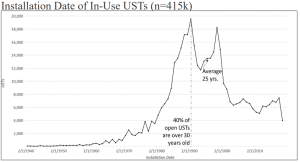 Contributed by Todd Perry, Principal, PPM Consultants
Contributed by Todd Perry, Principal, PPM Consultants
UST Systems store and dispense various substances, such as gasoline, diesel fuel, various chemicals, etc. However, the UST system components, such as tanks, lines, sumps, and fittings, can corrode, leak over time, and cause environmental and safety hazards. This is why monitoring, testing, and upgrading them before they fail is essential.
Currently, there are over 500,000 operating UST systems in the United States. The EPA estimates that 40 percent of operating USTs in the United States are over 30 years old, with an average age of 27 years. UST lifespan is typically discussed as “around 30 years” due to that number equaling the UST manufacturer’s typical warranty. However, many UST systems over 30 years old are still in good operational shape. Conversely, “younger” UST systems may not be, given the subsurface environment they reside in, the contents that are stored, and other site-specific conditions.

- One of the main reasons to upgrade USTs is to ensure compliance with rules and regulations. Depending on your location, federal, state, and/or local regulations will require USTs to meet specific performance and operational standards. The most recent Federal? regulations require USTs to have secondary containment, leak detection systems, monthly and annual walkthrough inspections, and many other compliance and safety features.
- Upgrading USTs helps prevent leaks and thus reduces the chance of soil and groundwater contamination. Newer USTs are designed with materials and features more resistant to corrosion and damage from the tank’s contents, reducing the risk of leaks. This is especially important when storing gasoline containing ethanol. Additionally, upgrading USTs can help you identify and address any issues before they become more significant problems.
- Improving performance is another important reason to upgrade USTs. Older USTs may not have newer USTs features, such as double-wall containment, automatic shut-offs, and alarms that alert you to potential issues. Upgrading to newer USTs can help ensure your system is compliant and safe for human health and the environment.
- While upgrading USTs is a significant upfront expense, it can save you money in the long run. Upgraded USTs reduce the risk of leaks and contamination, resulting in costly cleanup and remediation efforts. Additionally, newer USTs are more efficient, reducing operational costs over time.
So here is a general guide for “When should you upgrade your Underground Storage System (USTs).”
If your UST system was installed prior to 1988 and is single-walled or if your UST system’s components begin to fail, it is a good candidate for replacement.
If your UST system was installed after 1988 and is double-walled, with continuous interstitial monitoring, compatible with the ethanol and the new fuel blends, then your UST system typically has a long life expectancy.
Overall, upgrading your USTs is important to ensure compliance with regulations, prevent leaks and contamination, improve safety, and save money in the long run. Working with experienced professionals, such as PPM Consultants, can help you evaluate your UST systems in more detail and develop a plan to mitigate potential risks.

